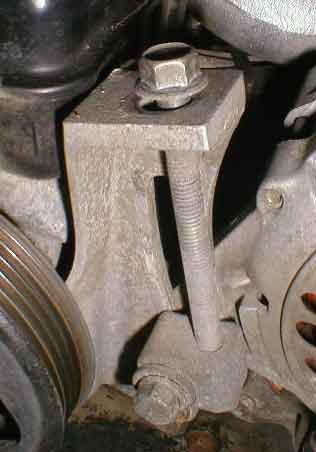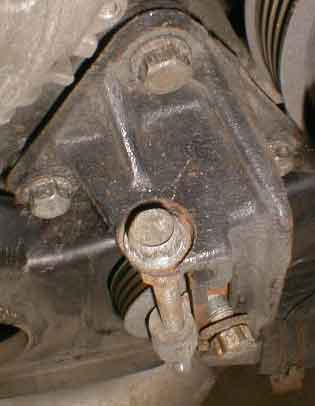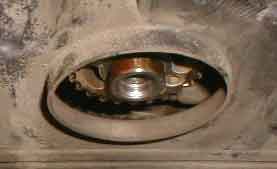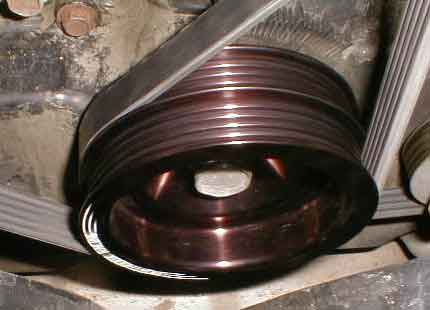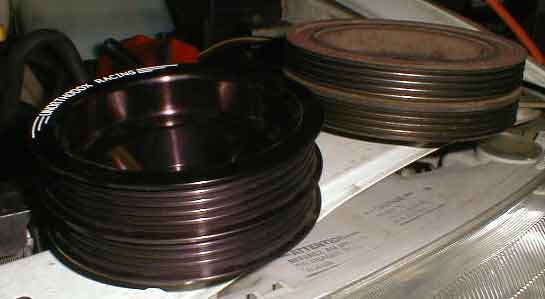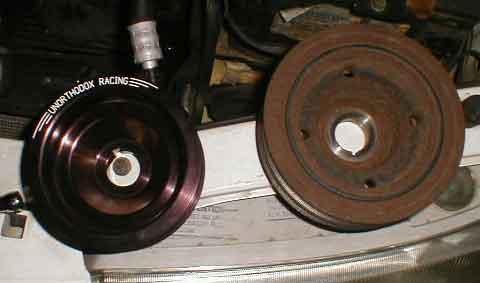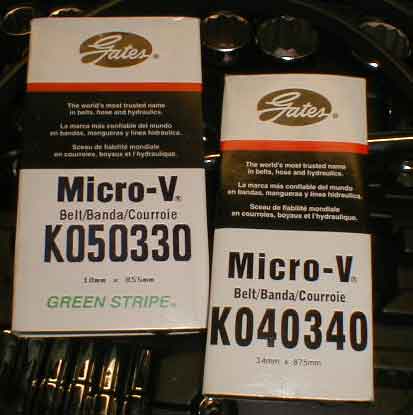|
Installing an Unorthodox Underdrive Pulley by Dave Available from Cobb Tuning What it does The concept and implimentation of using an smaller crankshaft pulley is not a new idea. I honestly don't know how long it's been around, but when browsing a '91 issue of Turbo magazine i found ads for "power pulleys", so it's nothing terribly new. The concept is simple: The crankshaft is the primary deliverer of power to the car, it rotates as the movement of the pistons accelerate it. The crankshaft is connected to the flywheel at the rear of the engine, while it's connected to the crankshaft pulley and sprocket at the other end. The sprocket powers the timing belt, which in turn spins the water pump and camshafts. The pulley on the end of the crankshaft drives the accesories, including the power steering pump, alternator and air conditioning compressor.
The Unorthodox underdrive pulley replaces this heavy stock pulley with a milled alluminum one, which is lighter and also slightly smaller in diameter. This serves to slow down the accessories within reason, and lightens the mass the crankshaft has to turn. This theoretically reduces the parasitic losses from driving the accesories and reduces the amount of weight the crankshaft must accelerate and decellerate. Rotational mass is a complex thing. The basic concept is that the farther out an amount of mass is from the center, the more effort is needed to accelerate that mass. Reducing the mass is helpful, this is especially true when applied to wheels, but reducing the distance from center is also extremely effective in helping acceleration. The pulley does both of these things. By reducing the load on the crankshaft, revs build up a little better and acceleration and horsepower should improve. I honestly can't tell much of a difference after install due to it being a turbocharged engine. Turbos mask a lot of things due to their non-linear nature, and the fact that it's a relatively snappy car anyway. More observations to follow!
Installation This is a job that can be done by all but the least mechanically inclined, there's nothing terribly difficult going on here. First things first, make sure the car has the brake on and is on a level surface. Don't work on a hot car, as you'll be in the vicinity of a number of normally warm components. You'll not need a lot of tools, mainly a 10, 12, 15 and 22mm socket, drivers and most importantly a breaker bar from the crankshaft pulley itself. A good light is helpful, and a rag to wipe off the dirty parts and grease you might encounter. Start off with removing the belt covers over the PS, AC and Alternator. Next, remove the coolant overflow tank and set it off to the side. Now comes the most tedious part, taking out the cooling fans. Remove the four top bolts, two on each fan, then get under the car and just loosen the four on the bottom without removing them, as the fans will slide easily out. Before removing them you'll need to disconnect the power connectors at the bottom. Take out the driver side fan first, then slide the passenger side one toward the center and remove it as well. Now to the belt removal. There are two tensioners, one is part of the alternator mount, whilst the other is below the AC compressor:
In order to loosen them, break loose the lower bolts on both and simply turn the top-facing bolts till they release tension. The alternator tensioner will extend and let the alternator move downward. keep loosening till the belt will just come off. The AC tensioner is separate from the compressor and presses the belt downwards. Turn the bolt so the tension wheel is drawn upwards and releases tension. Keep turning till the belt comes off. Now get your 22mm socket and breaker bar. If a breaker bar is not available, find a metal pipe of sufficient length and put it over the end of the ratchet. Here's where there's a difference between automatic and 5-speeds. In order to remove the pulley, we have to put a lot of pressure on it, but since the crankshaft is connected to the drivetrain, it'll spin if the gearbox is in reverse or park. On a 5-speed car, have someone apply the brakes and put the car in 5th gear. If the car is an automatic, find the TPS on the inlet to the intake manifold. To the left of the TPS, down on the block, there's a small hole where you can see the flywheel. There should be a hole in the flywheel large enought to fit something like a screwdriver in. Do so, or if the hole isn't visible, turn the crankshaft with the breaker till one is visible. This will keep the crankshaft from turning. Now take the breaker and push/pull very hard counter-clockwise. If the bolt hasn't been broken recently, it may be extremely tight. Once you've broken it, simply back out the bolt till it comes out, and pull the pulley off. Hold the stock pulley in one hand with the underdrive in the other, and you'll soon understand how big a difference it is. Note the key-notch in the pulley, this is crucial to putting the pulley back on correctly. Reach down and feel for the key on the crankshaft and get a general idea of its location if it's not visible. Take the new pulley and intentionally put it on so it doesn't match the key, then rotate it so you can feel it snap into the right spot. Turn it a little to make sure it's snug and so it feels flush against the shaft. Now put the bolt back in and tighten it up. I'm not sure what the torque specs are, as i'm going to borrow a wrench and find the exact specs, but you'd be hard pressed to tighten it too much. Take the new belts and install them. Take a close look and you'll find that one belt is both shorter and has a different number of grooves than the other, this is the belt that goes around the AC, install it and put some tension back in. Do the same with the PS/alternator. Tighten the tensioners so that the belt is tight but still has a bit of flex and will "twang" when flipped. Not exactly a scientific term, but it's the best way i can explain it.
(crankshaft end left, new pulley installed with belts on right) From here on out, go back and make sure everything is tight, and make sure and snug the tensioner keeps good, don't want belts flying off. Replace the fans, overflow and belt covers. Double check everything, make sure the fans are plugged in, etc... Start it up and make sure everything is in order, then go take it for a drive! More Pics
|


 The
stock pulley is large and heavy, made of cast iron or steel. It's actually
a two part piece with a layer of rubber between. Mine had begun to squeal
as the two layers slid past each other until they heated up. The pulley
is also larger in diameter as to keep sufficient power going to the
accesories.
The
stock pulley is large and heavy, made of cast iron or steel. It's actually
a two part piece with a layer of rubber between. Mine had begun to squeal
as the two layers slid past each other until they heated up. The pulley
is also larger in diameter as to keep sufficient power going to the
accesories. 